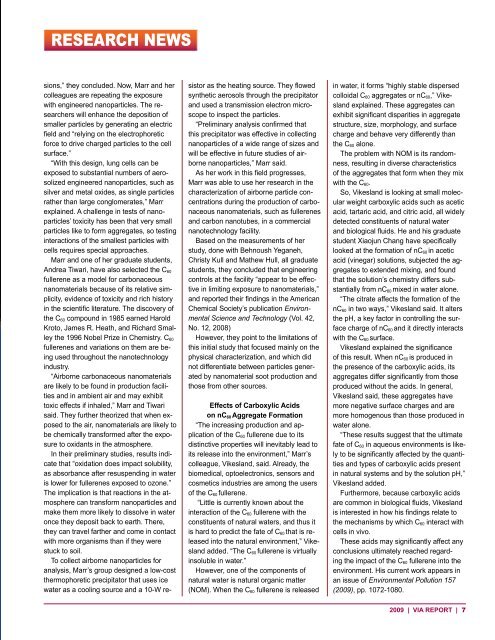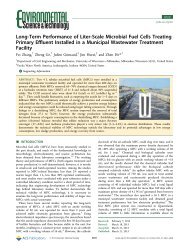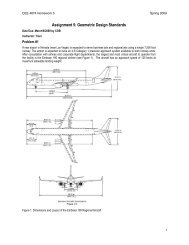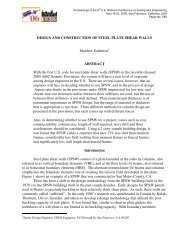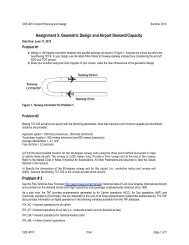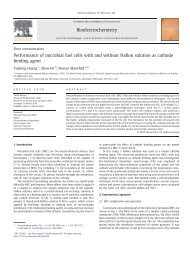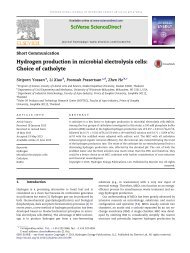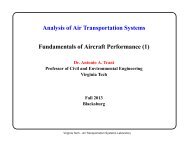Annual Report Year 2009 - Civil and Environmental Engineering
Annual Report Year 2009 - Civil and Environmental Engineering
Annual Report Year 2009 - Civil and Environmental Engineering
- No tags were found...
Create successful ePaper yourself
Turn your PDF publications into a flip-book with our unique Google optimized e-Paper software.
RESEARCH NEWS<br />
sions,” they concluded. Now, Marr <strong>and</strong> her<br />
colleagues are repeating the exposure<br />
with engineered nanoparticles. The researchers<br />
will enhance the deposition of<br />
smaller particles by generating an electric<br />
field <strong>and</strong> “relying on the electrophoretic<br />
force to drive charged particles to the cell<br />
surface.”<br />
“With this design, lung cells can be<br />
exposed to substantial numbers of aerosolized<br />
engineered nanoparticles, such as<br />
silver <strong>and</strong> metal oxides, as single particles<br />
rather than large conglomerates,” Marr<br />
explained. A challenge in tests of nanoparticles’<br />
toxicity has been that very small<br />
particles like to form aggregates, so testing<br />
interactions of the smallest particles with<br />
cells requires special approaches.<br />
Marr <strong>and</strong> one of her graduate students,<br />
Andrea Tiwari, have also selected the C 60<br />
fullerene as a model for carbonaceous<br />
nanomaterials because of its relative simplicity,<br />
evidence of toxicity <strong>and</strong> rich history<br />
in the scientific literature. The discovery of<br />
the C 60 compound in 1985 earned Harold<br />
Kroto, James R. Heath, <strong>and</strong> Richard Smalley<br />
the 1996 Nobel Prize in Chemistry. C 60<br />
fullerenes <strong>and</strong> variations on them are being<br />
used throughout the nanotechnology<br />
industry.<br />
“Airborne carbonaceous nanomaterials<br />
are likely to be found in production facilities<br />
<strong>and</strong> in ambient air <strong>and</strong> may exhibit<br />
toxic effects if inhaled,” Marr <strong>and</strong> Tiwari<br />
said. They further theorized that when exposed<br />
to the air, nanomaterials are likely to<br />
be chemically transformed after the exposure<br />
to oxidants in the atmosphere.<br />
In their preliminary studies, results indicate<br />
that “oxidation does impact solubility,<br />
as absorbance after resuspending in water<br />
is lower for fullerenes exposed to ozone.”<br />
The implication is that reactions in the atmosphere<br />
can transform nanoparticles <strong>and</strong><br />
make them more likely to dissolve in water<br />
once they deposit back to earth. There,<br />
they can travel farther <strong>and</strong> come in contact<br />
with more organisms than if they were<br />
stuck to soil.<br />
To collect airborne nanoparticles for<br />
analysis, Marr’s group designed a low-cost<br />
thermophoretic precipitator that uses ice<br />
water as a cooling source <strong>and</strong> a 10-W resistor<br />
as the heating source. They flowed<br />
synthetic aerosols through the precipitator<br />
<strong>and</strong> used a transmission electron microscope<br />
to inspect the particles.<br />
“Preliminary analysis confirmed that<br />
this precipitator was effective in collecting<br />
nanoparticles of a wide range of sizes <strong>and</strong><br />
will be effective in future studies of airborne<br />
nanoparticles,” Marr said.<br />
As her work in this field progresses,<br />
Marr was able to use her research in the<br />
characterization of airborne particle concentrations<br />
during the production of carbonaceous<br />
nanomaterials, such as fullerenes<br />
<strong>and</strong> carbon nanotubes, in a commercial<br />
nanotechnology facility.<br />
Based on the measurements of her<br />
study, done with Behnoush Yeganeh,<br />
Christy Kull <strong>and</strong> Mathew Hull, all graduate<br />
students, they concluded that engineering<br />
controls at the facility “appear to be effective<br />
in limiting exposure to nanomaterials,”<br />
<strong>and</strong> reported their findings in the American<br />
Chemical Society’s publication <strong>Environmental</strong><br />
Science <strong>and</strong> Technology (Vol. 42,<br />
No. 12, 2008)<br />
However, they point to the limitations of<br />
this initial study that focused mainly on the<br />
physical characterization, <strong>and</strong> which did<br />
not differentiate between particles generated<br />
by nanomaterial soot production <strong>and</strong><br />
those from other sources.<br />
Effects of Carboxylic Acids<br />
on nC 60 Aggregate Formation<br />
“The increasing production <strong>and</strong> application<br />
of the C 60 fullerene due to its<br />
distinctive properties will inevitably lead to<br />
its release into the environment,” Marr’s<br />
colleague, Vikesl<strong>and</strong>, said. Already, the<br />
biomedical, optoelectronics, sensors <strong>and</strong><br />
cosmetics industries are among the users<br />
of the C fullerene.<br />
60<br />
“Little is currently known about the<br />
interaction of the C 60 fullerene with the<br />
constituents of natural waters, <strong>and</strong> thus it<br />
is hard to predict the fate of C 60 that is released<br />
into the natural environment,” Vikesl<strong>and</strong><br />
added. “The C 60 fullerene is virtually<br />
insoluble in water.”<br />
However, one of the components of<br />
natural water is natural organic matter<br />
(NOM). When the C 60 fullerene is released<br />
in water, it forms “highly stable dispersed<br />
colloidal C 60 aggregates or nC 60,” Vikesl<strong>and</strong><br />
explained. These aggregates can<br />
exhibit significant disparities in aggregate<br />
structure, size, morphology, <strong>and</strong> surface<br />
charge <strong>and</strong> behave very differently than<br />
the C 60 alone.<br />
The problem with NOM is its r<strong>and</strong>omness,<br />
resulting in diverse characteristics<br />
of the aggregates that form when they mix<br />
with the C 60.<br />
So, Vikesl<strong>and</strong> is looking at small molecular<br />
weight carboxylic acids such as acetic<br />
acid, tartaric acid, <strong>and</strong> citric acid, all widely<br />
detected constituents of natural water<br />
<strong>and</strong> biological fluids. He <strong>and</strong> his graduate<br />
student Xiaojun Chang have specifically<br />
looked at the formation of nC 60 in acetic<br />
acid (vinegar) solutions, subjected the aggregates<br />
to extended mixing, <strong>and</strong> found<br />
that the solution’s chemistry differs substantially<br />
from nC 60 mixed in water alone.<br />
“The citrate affects the formation of the<br />
nC 60 in two ways,” Vikesl<strong>and</strong> said. It alters<br />
the pH, a key factor in controlling the surface<br />
charge of nC 60 <strong>and</strong> it directly interacts<br />
with the C surface.<br />
60<br />
Vikesl<strong>and</strong> explained the significance<br />
of this result. When nC 60 is produced in<br />
the presence of the carboxylic acids, its<br />
aggregates differ significantly from those<br />
produced without the acids. In general,<br />
Vikesl<strong>and</strong> said, these aggregates have<br />
more negative surface charges <strong>and</strong> are<br />
more homogenous than those produced in<br />
water alone.<br />
“These results suggest that the ultimate<br />
fate of C 60 in aqueous environments is likely<br />
to be significantly affected by the quantities<br />
<strong>and</strong> types of carboxylic acids present<br />
in natural systems <strong>and</strong> by the solution pH,”<br />
Vikesl<strong>and</strong> added.<br />
Furthermore, because carboxylic acids<br />
are common in biological fluids, Vikesl<strong>and</strong><br />
is interested in how his findings relate to<br />
the mechanisms by which C 60 interact with<br />
cells in vivo.<br />
These acids may significantly affect any<br />
conclusions ultimately reached regarding<br />
the impact of the C 60 fullerene into the<br />
environment. His current work appears in<br />
an issue of <strong>Environmental</strong> Pollution 157<br />
(<strong>2009</strong>), pp. 1072-1080.<br />
<strong>2009</strong> | VIA REPORT | 7


